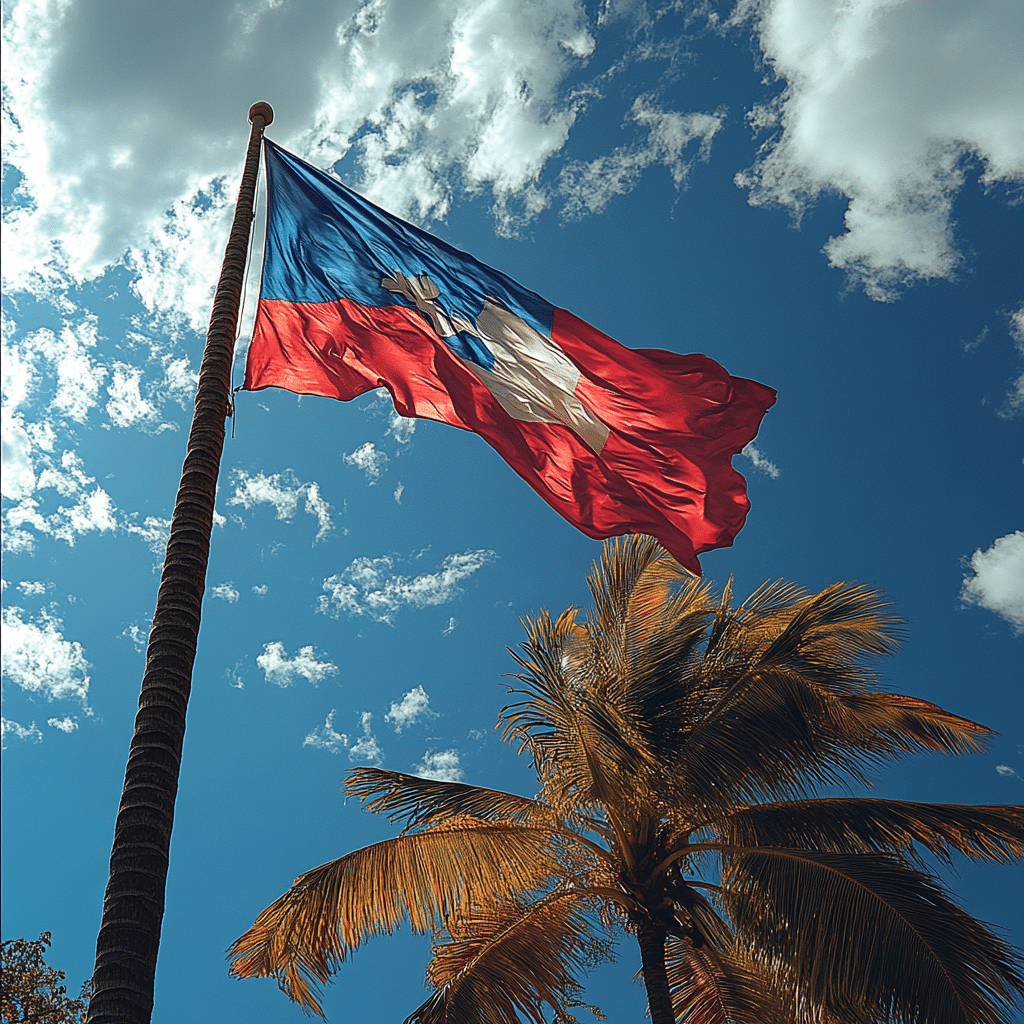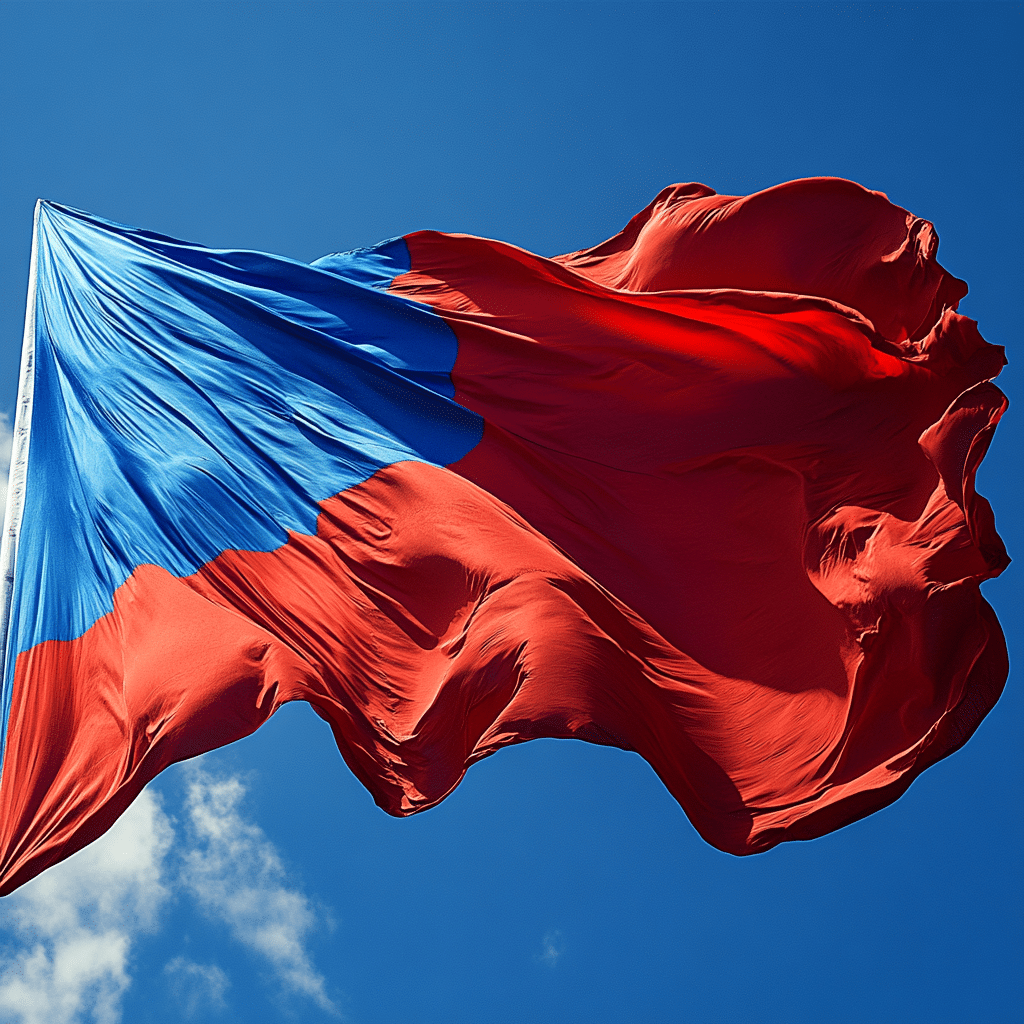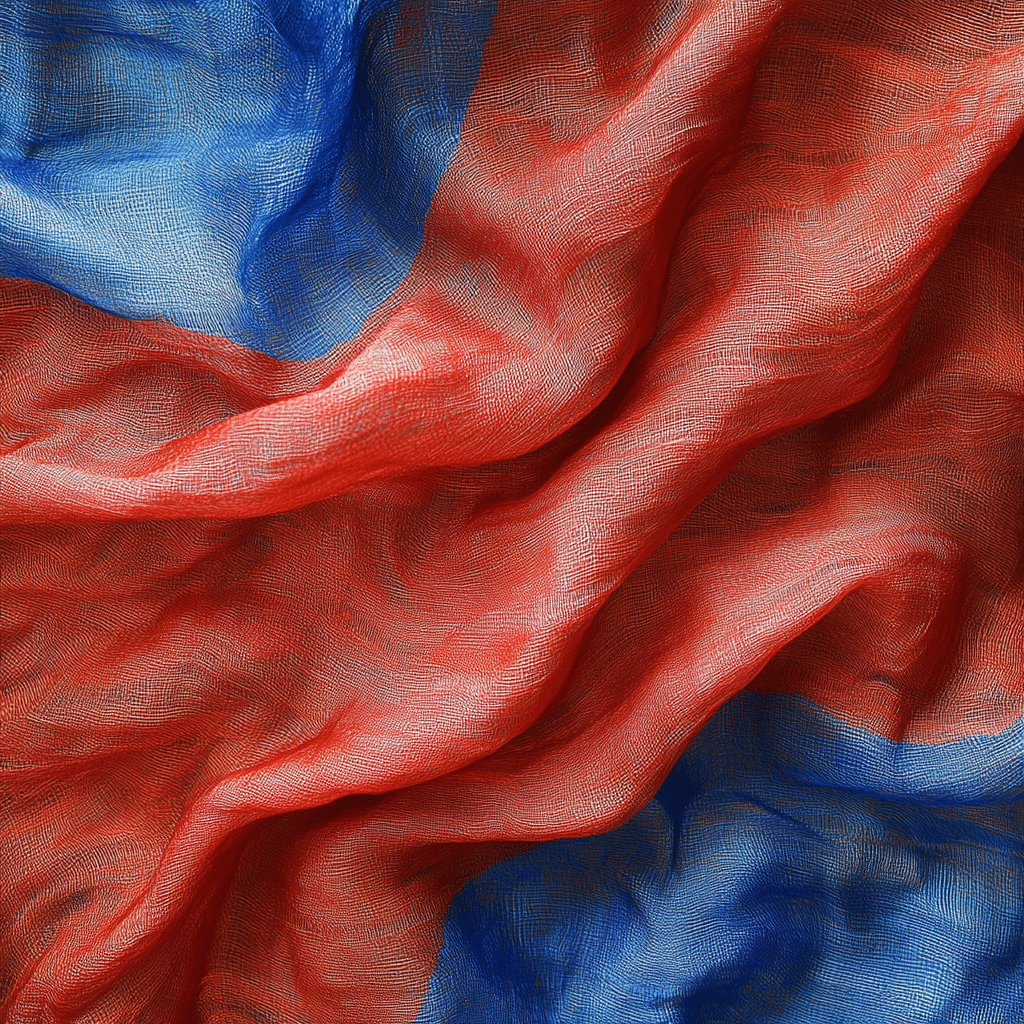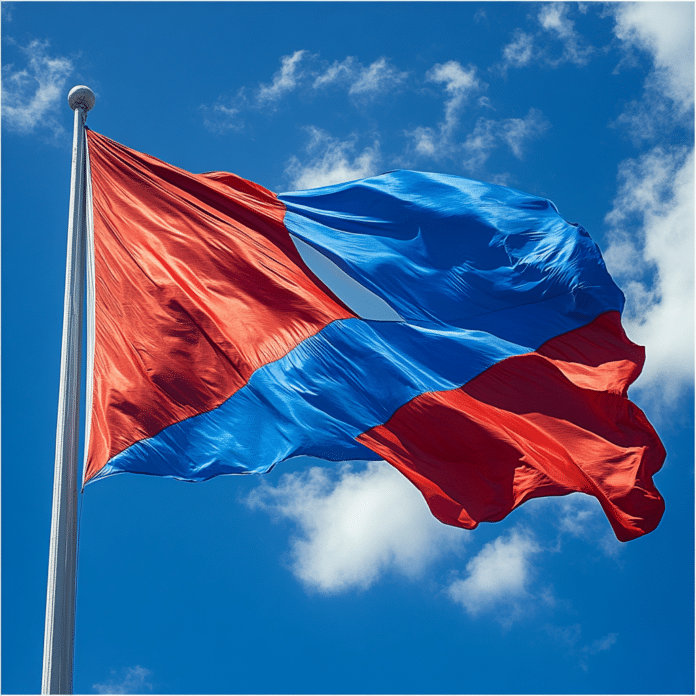The Haitian flag, with its striking blue and red colors, tells a powerful story of resilience and national pride. Adopted on May 18, 1803, during the pivotal Haitian Revolution, it embodies not only Haiti’s fight against colonialism but also the hopes and struggles of its people. The blue represents the African population, while the red symbolizes the indigenous peoples. The white emblem in the center of the flag, found in the coat of arms, stands for peace—a beacon amidst a history filled with turmoil. The Haitian flag is more than a piece of cloth; it plays an integral role in the fabric of Haitian identity, reminding citizens of their shared past and their unified aspirations for the future.
The Significance of the Haitian Flag in National Identity
The Haitian flag is a prominent symbol woven into the very essence of Haiti’s national identity. When the French Tricolor was initially used, it represented hopes for freedom. However, in a revolutionary act at the Arcahaie Congress in 1803, Jean-Jacques Dessalines removed the white stripe, creating a new flag that embodied the unity of black and mulatto populations in their struggle for independence. The Haitian flag stands as a testimony to their determination to forge a distinct identity.
Every May 18, Flag Day sparks nationwide celebrations. From parades that fill the streets with vibrant colors to communal gatherings echoing with music and laughter, Haitians express immense pride in their flag. Wearing red and blue, painting their faces, and waving the Haitian flag high, they commemorate their collective achievements and the ongoing pursuit of freedom and unity. This day truly exemplifies how the Haitian flag nurtures a strong sense of belonging among its people.
Moreover, the flag serves as a unifying force in times of crisis. Following the devastating earthquake in 2010, the Haitian flag was a rallying point for grassroots movements that facilitated recovery efforts. Citizens unfurled the flag as they came together to support one another, reinforcing hope in an uncertain world. The flag’s presence was vital, reminding everyone of their shared strength and resilience in overcoming adversity.

Top 5 Influences of the Haitian Flag on Culture and Society
Comparing the Haitian Flag to Other Flags: A Study of Color and Symbolism
When we think of flags, the Haitian flag shares important similarities with those of other nations. In particular, the red, yellow, and green flag of Ethiopia invokes a sense of pride related to anti-colonial struggles. Both flags symbolize the fight for freedom, yet they reflect different historical narratives. This connection highlights how flags can convey profound identities and shared experiences in the African diaspora.
On the other hand, the red, white, and blue flags of nations like the United States and France represent their unique stories of revolution and individual rights. While these flags celebrate democracy, their narratives diverge from the Haitian flag’s focus on unity and collective resilience, symbolizing the particular challenges faced by the Haitian people.
This diverse array reminds us that flags—like art—can symbolize varied histories and dreams. The Haitian flag, resplendent in blue and red, speaks volumes about Haiti’s journey toward independence. It fosters a connection not only among Haitians but also resonates with those who share common struggles for freedom and unity.

The Flag and Anthem: A Harmonious Representation of National Identity
Accompanying the Haitian flag is the national anthem, “La Dessalinienne,” which echoes the values and aspirations embodied in the flag. The anthem enriches the experience of national pride, featuring themes of resistance against oppression. Together, the Haitian flag and anthem forge a cohesive narrative that resonates deeply with citizens both in Haiti and the diaspora.
Every time the anthem plays or the flag is raised, a wave of pride washes over the people. It represents not just the past but also the promise of a united future. As national celebrations unfold, the harmonious relationship between the flag and anthem encapsulates Haiti’s enduring spirit.
The cultural significance of this synergy even extends to international gatherings where Haitian citizens proudly display their flag while singing their anthem. This display fosters a collective sense of identity and community, reinforcing their connection to the roots and dreams symbolized by both the Haitian flag and “La Dessalinienne”.
Regional Variations: The Green, White, and Red Flag of Other Caribbean Nations
Throughout the Caribbean, colors like green, white, and red carry unique meanings in different national flags. For instance, the flag of Cuba showcases stripes of blue, white, and red, with the red representing the blood of patriots who fought for independence. This theme resonates similarly with the Haitian flag, reflecting common struggles for sovereignty.
The green, white, and red flag of Mexico, while distinct in its narrative, also invokes feelings of pride linked to its history and dedication to independence. The imagery on this flag conveys a rich tapestry of meanings, paralleling the emotive power found in Haiti’s national symbols.
Despite these variations, a thread connects these flags, underscoring universal themes of pride, heritage, and the shared experiences of former colonies striving for identity. The Haitian flag aligns itself within this broader narrative, serving as a reminder of the fight against imperialism and the importance of unity, no matter the colors displayed.
Fostering Future Unity Through Symbolism
Today, as Haiti grapples with various challenges, the Haitian flag remains a steadfast symbol of unity and perseverance. It transcends generations, uniting citizens around shared ideals and collective identity. As Haiti faces a complex sociopolitical landscape, the ongoing presence of the flag in both domestic and international events reinforces its significance.
The Haitian flag is more than just cloth. It’s a testament to the indomitable spirit of its people, a symbol that continues to inspire hope and resilience. As Haiti moves forward, the flag will be there, waving proudly as a reminder of the struggle for freedom and the quest for unity.
In a world where national identity is often tested, the Haitian flag stands tall, connecting hearts under the inspiring motto “L’Union fait la force”—Unity makes strength. Through every challenge and triumph, it remains a powerful emblem of pride, resilience, and togetherness.
The Haitian Flag: A Symbol of Unity and Freedom in Haiti
A Tapestry of Colors and Meanings
The Haitian flag, a vibrant blend of blue and red, holds a significant place in the hearts of the Haitian people. Each color symbolizes a piece of their tumultuous history. The blue represents the country’s black population, while the red signifies the blood of the brave who fought for independence. What’s fascinating is that on some occasions, observers can connect these colors to other symbols of unity, like the various scriptures on peace that echo similar themes across cultures. Just as those scriptures inspire harmony, the Haitian flag inspires pride and resilience.
Did you know that the flag’s design features the coat of arms of Haiti? This emblem showcases a trophy of weapons surrounded by palm trees, symbolizing the nation’s readiness to defend its freedom. The connection between Haiti and the concept of freedom is made even more poignant when considering that Haiti became the first independent nation in Latin America and the Caribbean in 1804—an extraordinary achievement, especially when compared to other nations celebrated in the media, like what is the current interest rate on mortgages in the U.S., which often distracts from historical liberation narratives like Haiti’s.
The Flag’s Journey Across Time
Haiti’s flag has evolved over the years, with its most prominent change occurring in the late 19th century. After a brief period, it was reverted to its original design, symbolizing the nation’s tenacity. The flag’s presence is not just limited to its borders; it travels abroad with diplomats and sports teams, rallying the global diaspora. On the topic of cultural representation, it’s intriguing how flags affect national pride—some might even liken it to how woody harrelson snl episodes create buzz in American pop culture. Just as Wood’s humor unites viewers, the Haitian flag brings together people, transcending continents.
Now, if you’re wondering how the symbolism of national flags holds up in sports, you might be surprised! For instance, during games like espana vs alemania, national pride runs high as teams fight for glory, much like how Haitian athletes carry their flag with pride. The emotion tied to these flags mirrors the personal stories we encounter in today’s global society, including inspiring figures like sasha piqué mebarak, who resonate with many for their contributions despite challenges.
Haitians celebrate Flag Day on May 18 every year, a testament to their enduring spirit. In a nation that has faced severe challenges, the emblem of the Haitian flag stands tall, just like moments of joy shared through an eskimo kiss, highlighting the intimacy and warmth of human connection. The flag isn’t just a piece of cloth; it’s a powerful symbol of unity, hope, and the unwavering quest for freedom that speaks to every Haitian and friend of Haiti around the world.

What is the meaning behind Haiti’s flag?
Haiti’s flag represents the unity and resilience of its people. The blue and red colors symbolize the alliance of blacks and mulattos, while the coat of arms reflects independence and a commitment to freedom.
What flag is 🇭🇹?
The flag 🇭🇹 represents Haiti, showcasing the bicolor design of blue and red, with a white panel at the center displaying the nation’s coat of arms.
What is Haiti’s motto?
Haiti’s motto is “L’Union fait la force,” which means “Unity makes strength.” This phrase emphasizes the importance of togetherness among the Haitian people.
Is it Haitian flag day?
Yes, Flag Day is celebrated in Haiti on May 18 each year, marking the anniversary of the flag’s adoption in 1803. It’s a vibrant event filled with pride and cultural festivities.
Is Haitian considered Caribbean?
Haiti is indeed considered a Caribbean country, located on the island of Hispaniola, which it shares with the Dominican Republic.
Did the Dominican flag come from Haiti?
The Dominican flag was influenced by the Haitian flag during the period of Haitian rule, but it has distinct elements that represent Dominican identity.
Which country flag is 🏳 🌈?
The flag 🏳 🌈 is the pride flag, representing the LGBTQ+ community and symbolizing diversity and acceptance.
Which country is the 🏴 flag?
The flag 🏴 represents a black flag, which can signify various meanings, often related to piracy or an absence of a specific country flag.
What does 🇮 🇳 mean?
The emoji 🇮 🇳 stands for India, using regional indicator symbols to represent the country’s name.
How do Haiti say hello?
In Haiti, people often say “Bonjour” for hello, reflecting the French influence on the language spoken in the country.
What animal represents Haiti?
The national animal of Haiti is the Hispaniolan Flagwing butterfly, which holds significance in Haiti’s biodiversity.
What is Haiti’s real name?
Haiti’s real name is “La République d’Haïti,” which translates to “The Republic of Haiti” in English.
What is the most popular food in Haiti?
The most popular food in Haiti is Griot, a dish made from marinated and fried pork, often served with rice and beans.
What flag is identical to Haiti?
The flag of Paraguay is identical to Haiti’s flag, as both feature similar colors and emblematic designs.
What is Haitian culture?
Haitian culture is rich and diverse, influenced by African traditions, French colonial history, and local indigenous customs, expressed through music, art, and cuisine.
What is Haiti known for?
Haiti is known for its vibrant culture, historical significance as the first independent black republic, and beautiful natural landscapes.
Which country is 🇹🇭?
The flag 🇹🇭 represents Thailand, characterized by its unique colors and design.
What is on the Barbados flag?
The Barbados flag features three vertical stripes: a golden middle stripe flanked by two ultramarine stripes, with a black trident head in the center, symbolizing strength.
Is Haitian African country?
Haiti is considered an African diasporic country due to its historical connections with Africa through slavery and cultural influences.
What symbols represent Haiti?
Symbols of Haiti include its flag, coat of arms, and national flowers, which collectively embody the nation’s identity and heritage.
What is the meaning of the Easter Island flag?
The Easter Island flag features a simple design of a white background with a red Rapa Nui (Easter Island) moai, symbolizing the island’s indigenous culture.
What does ex Cineribus Nascitur mean?
“Ex Cineribus Nascitur” means “Out of ashes, we are born,” symbolizing rebirth or resilience following destruction, often associated with renewal or hope.
Where is Haiti 🇭 🇹?
Haiti is located on the Caribbean island of Hispaniola, sharing this land with the Dominican Republic to the east.



